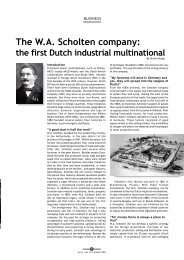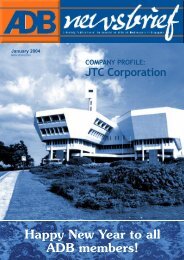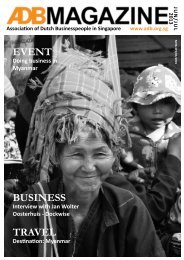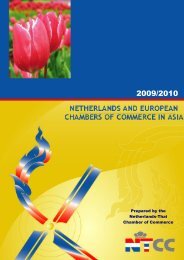June 2004 - Association of Dutch Businessmen
June 2004 - Association of Dutch Businessmen
June 2004 - Association of Dutch Businessmen
Create successful ePaper yourself
Turn your PDF publications into a flip-book with our unique Google optimized e-Paper software.
➤<br />
BUSINESS<br />
4.17 million hungry mouths to feed<br />
By Han van der Broek<br />
If you think the Netherlands is “full”, come to Singapore. Whereas the<br />
Netherlands has a population density <strong>of</strong> 388 per sq. km., Singapore is host<br />
to a staggering 6,055 per sq. km. (www.sedb.com). That is almost a 16<br />
times higher density. No wonder that people have to live ‘on top <strong>of</strong> each<br />
other’ and there is hardly any place left for agriculture. In 1999, only 1.6%<br />
<strong>of</strong> its total land area was arable and permanent cropland (Netherlands:<br />
23%). This percentage has more than likely come down since then, judging<br />
the ongoing development in construction.<br />
Pigs<br />
Indonesia<br />
Fruits<br />
Malaysia<br />
USA<br />
China<br />
Australia<br />
Thailand<br />
➤<br />
➤<br />
Frozen Pork<br />
China<br />
Netherlands<br />
Denmark<br />
France<br />
United Kingdom<br />
Map <strong>of</strong> Food Supply<br />
Lamb<br />
Australia<br />
New Zealand<br />
➤<br />
➤<br />
Chilled Pork<br />
Australia<br />
New Zealand<br />
So, with 4.17 million hungry mouths to feed and<br />
little room for agriculture, where does Singapore<br />
get its food items?<br />
It starts with the Agri-Food and Veterinary<br />
Authority (AVA). AVA monitors Singapore’s food<br />
supply. AVA strives to provide Singapore with an<br />
adequate supply <strong>of</strong> safe primary food. They<br />
achieve this through the import <strong>of</strong> food items from<br />
diversified sources as well as through increased<br />
self-sufficiency by employing intensive farming<br />
systems (www.ava.gov.sg).<br />
Import<br />
Singapore imports 90% <strong>of</strong> its food requirements<br />
and is constantly looking for new sources <strong>of</strong> food<br />
Fish<br />
Thailand<br />
Malaysia<br />
Indonesia<br />
➤<br />
➤<br />
Beef<br />
New Zealand<br />
Australia<br />
Brazil<br />
Poultry<br />
USA<br />
Denmark<br />
Thailand<br />
Brazil<br />
China<br />
➤<br />
➤<br />
➤<br />
Hen Eggs<br />
Malaysia<br />
Poultry<br />
Malaysia<br />
for Singapore consumers.<br />
Import <strong>of</strong> food items comes<br />
from various countries,<br />
as can be seen on the<br />
enclosed map (source:<br />
AVA). A deliberate food<br />
diversification programme<br />
allows Singapore to have<br />
resilience in supply, giving<br />
increased flexibility and<br />
adaptability when supply<br />
from a particular source<br />
falls short. This has helped<br />
to maintain stability in the prices <strong>of</strong> primary<br />
produce.<br />
Intensive farming<br />
In 1986, AVA embarked on its Agrotechnology<br />
Programme, which included the development <strong>of</strong><br />
Agrotechnology parks to house modern intensive<br />
farms. There are currently six Agrotechnology<br />
parks in Singapore. They are located at Lim<br />
Chu Kang, Murai, Sungei Tengah, Mandai, Nee<br />
Soon, and Loyang. These parks occupy a total<br />
land area <strong>of</strong> 1,465 ha and nearly 800 ha have<br />
been allocated to over 200 farms for the<br />
production <strong>of</strong> livestock, eggs, milk, aquarium<br />
and food fish, vegetables, fruits, orchids,<br />
ornamental and aquatic plants, as well as<br />
for the breeding <strong>of</strong> birds and dogs.<br />
‘Veggies’<br />
There are 66 vegetable farms in the<br />
Agrotechnology Parks, which produce mainly leafy<br />
vegetables and bean sprouts. More than 80% <strong>of</strong> the<br />
leafy vegetables produced are derived from soil<br />
cultivation under protective netting which protects<br />
the vegetables underneath from sunlight and birds.<br />
A substantial amount <strong>of</strong> fruits and vegetables are<br />
imported. Singapore, aside from importing most<br />
<strong>of</strong> its water from Malaysia, obtains most <strong>of</strong> its<br />
vegetables from its nearest neighbour. Tomatoes<br />
and potatoes are grown in the cooler climates <strong>of</strong><br />
the Cameron Highlands for example. In another<br />
effort to diversify its vegetable supply, Singapore<br />
and the Indonesian island Riau established a<br />
vegetable project in Pekan Baru in 2002. This Riau<br />
Vegetable Project has created employment and<br />
generates income for Indonesian farmers in Riau<br />
and <strong>of</strong> course provides an additional source <strong>of</strong><br />
food supply for Singapore.<br />
Eggs<br />
There are currently five<br />
layer farms in Singapore with<br />
a total daily production <strong>of</strong><br />
1.1 million eggs, catering<br />
to about 30% <strong>of</strong> the daily<br />
consumption <strong>of</strong> three million<br />
eggs. The other 70% comes from<br />
Malaysia. Singaporeans consume a total <strong>of</strong> 1,023<br />
million eggs with an estimated value <strong>of</strong> $102.3<br />
million annually. Egg consumption has increased<br />
by at least 50% in the past decade. The five layer<br />
farms use improved breeds and modern feed<br />
technology to ensure balanced and wholesome<br />
rations for the chickens. They also apply latest<br />
zoo-sanitary measures so as to reduce dependence<br />
on drugs to control diseases. This ensures that the<br />
eggs produced are not only fresh and wholesome<br />
but also free <strong>of</strong> drug residues. The two leading<br />
egg farms in Singapore are also <strong>of</strong>fering designer<br />
eggs that are enriched in vitamins, healthy<br />
omega-3 and –6 fatty acids, selenium or lutein.<br />
Red meat<br />
Singapore’s consumption <strong>of</strong> beef, pork and chilled<br />
processed meats amounts to 17,000 tonnes, 69,000<br />
tonnes and 7,000 tonnes respectively. While all beef<br />
and pork is imported, over 85% <strong>of</strong> chilled processed<br />
meat supplies are locally manufactured. Beef<br />
has a large niche type market, the development<br />
<strong>of</strong> which has been constrained by concerns over<br />
BSE and religious beliefs. Beef consumption is<br />
constrained by the fact that half <strong>of</strong> Singapore’s<br />
population are Buddhists or Hindus that do not<br />
consume beef for religious reasons. Nevertheless,<br />
50% <strong>of</strong> the Singaporeans plus a large number <strong>of</strong><br />
expats, as well as business and tourist visitors are<br />
3<br />
Vol.14 • No. 6 • <strong>June</strong> <strong>2004</strong>















